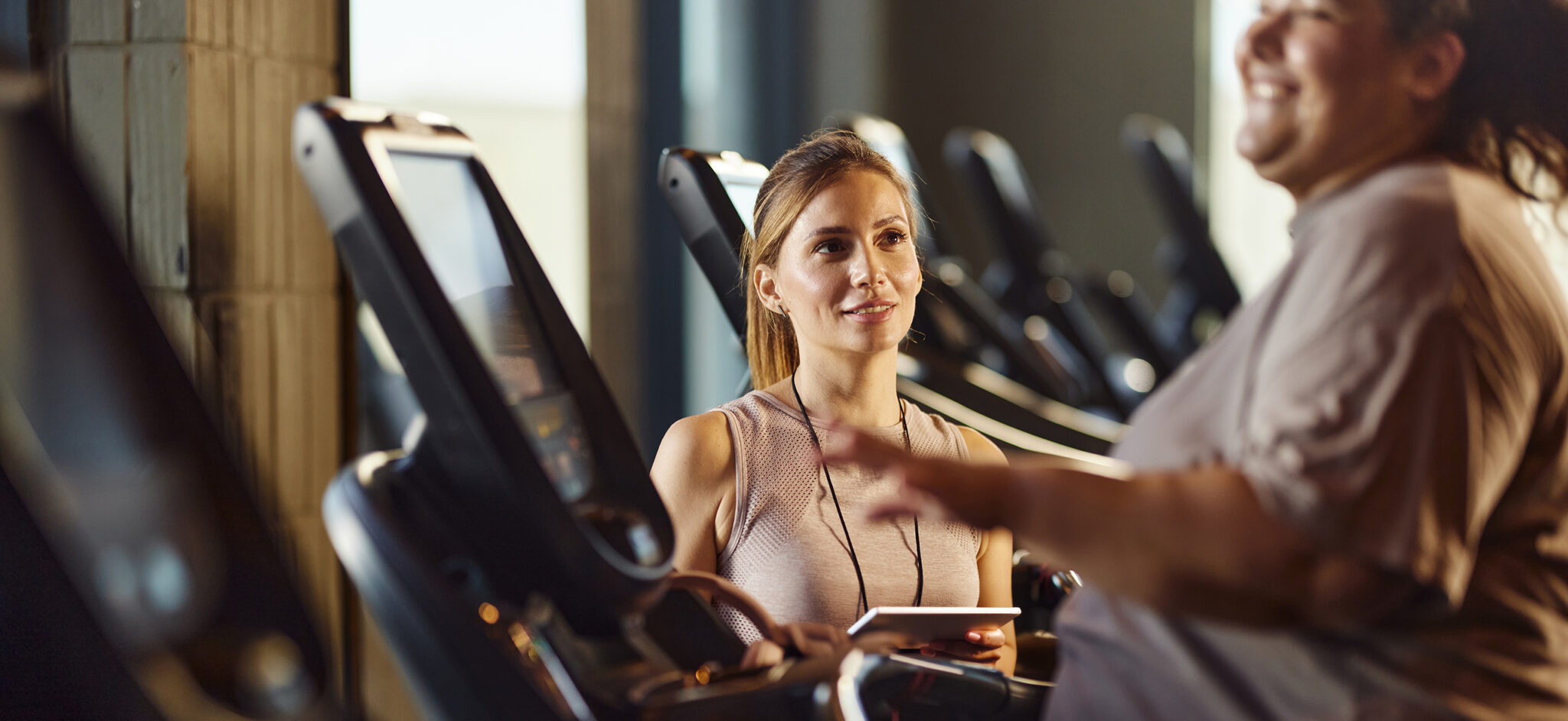SEO for gyms and fitness clubs is the essential way to organically attract new members in the long-term. This complete guide gives you all you need to master SEO. So, you can elevate your online presence and win new members.
There are just over 4,500 privately owned health and fitness clubs in the UK – up by 1.2% on 2023 according to LeisureDB.
The marketplace is competitive. And has been dominated by budget operators in the past few years. So, you need to make sure your business is easily found – both offline and online too.
Online, search engine optimisation (SEO) is the tried and tested way of getting found. Make sure your website is optimised to show up for relevant searches using Google and other search engines. And you’ll be easily found by potential new members.
Ready to improve how you show up? Read on to learn more about:
- Why SEO for gyms and fitness clubs is so important
- What to focus on to make gym SEO work for your fitness business
Let’s get stuck in!
Quick takeaways
Short on time? No sweat! Here are your quick takeaways:
- SEO offers a cost-effective, long-term way to attract new members. It helps you build trust, local credibility, and awareness in a competitive market
- Despite the rise of TikTok, Instagram, and AI tools like ChatGPT, SEO remains vital as the landscape evolves. Working to meet Google’s algorithms can make sure your content stays valuable and discoverable
- To achieve high rankings locally, you need a well-structured website that’s optimised for local searches. And a complete Google Business Profile with strong reviews
- Drive organic traffic through thorough keyword research combined with high-quality, engaging content. Optimise title tags, meta descriptions, and headings
- Make sure your website meets technical requirements to boost crawlability and indexing. Prioritise fast page speeds, a mobile-first approach, secure HTTPS connections, XML sitemaps, and use of structured data
- Track success. Look at keyword rankings, organic traffic, visitor engagement (time on page, bounce rate), and quality of backlinks. Keep refining your strategy
What is SEO for gyms?
SEO for gyms is the process of optimising your website to appear at the top of a search engine results page (SERP).
SERP
DefinitionSERP stands for Search Engine Results Page. This is the page that search engines show in response to a search query.
By employing SEO best practices, you’ll help make sure your website shows up for groups of and specific keywords. For example, if a prospect searches for “gyms near me”, you’ll want to show up at the top of that page.
Broadly, Gym SEO works by optimising the following aspects of your website and online presence:
- Content – using the right keywords in titles, descriptions, headings and elsewhere on web pages. And making sure that content is easy to read and relevant for the audience
- Technical set up – making sure that technical aspects of your website meet recommended guidance. For example, hosting, redirects, site maps, and error pages
- User experience – creating a website that’s easy to use, fast enough, and provides a good experience for visitors
- Links – building quality links to your website from others
Google is often the focus for most operators as 93% of searches across all devices use the search engine.
Power up your business & stay in the know
Why does SEO for gyms matter?
For gyms and fitness clubs, SEO matters as it’s a sustainable way to attract your target audience to your website.
It’s a cost-effective way to market your business
SEO can seem complex with algorithms changing on a regular basis. Yet it’s not that complicated – get the basics right and you’ll only need to put in occasional effort.
Algorithm
DefinitionAn Algorithm is a set of rules used by a search engine to rank the best results when someone performs a search.
If you’re able to handle SEO yourself or if your team can, it doesn’t need to cost you anything. Especially compared to pay-per-click (PPC) advertising on Google or Meta. And it’s a way to promote your business 24/7.
It maximises your PPC campaigns
Organic (SEO) and paid marketing strategies (like PPC) go well together:
- Google Ads help you appear at the top of paid search results
- SEO helps you appear at the top of organic results
Appearing in both places when prospects search, can help show your brand is credible. You’re not just paying to show up. And you can even use SEO to optimise PPC campaigns – investing in ads for keywords that your website ranks well for.
It can help you reach a broader audience
SEO is a form of always-on gym marketing. And unlike specific campaigns that run for a defined period, it can help you attract anyone with intent at any time. So, it helps you reach more of your target audience.
It helps you show up for local searches
Local SEO is particularly important for gyms. Local searches can help you get found by people looking for gyms close to your location or locations.
Searches like ‘gym near me’ or ‘best gyms near me’ are often carried out by people who are ready to buy a membership or attend a club. So, it’s a great way to attract more members.
It builds trust and creates a competitive advantage
Want to boost your credibility? A website that ranks high up on search engine results pages is typically perceived as trustworthy and high-quality. That’s by both search engines and searchers.
And if you invest strategically in SEO, you’ll be more likely to outrank your competitors – and so gain market share of new members.
Research has found that the number 1 result in Google’s organic search results gets an average click through rate of 27.6%. And that top result is 10x more likely to receive a click compared to a page that’s the number 10 result.
It helps you attract new members
Reaching more of your target audience. Showing up when people are looking for local fitness clubs. Increased trust and higher rankings. All this helps you attract new members – so you can continue to grow your business.

Is SEO becoming obsolete?
TikTok. Instagram. Generative AI tools like ChatGPT. The way people are finding information is changing. But SEO is not becoming obsolete, it is evolving though.
Google remains the largest source of traffic for most websites. So, SEO is still a crucial part of any gym marketing strategy.
Plus, the way that generative AI finds and references info from websites is driven by the same or similar algorithms to those used by Google and Bing.
SEO is always evolving, and it will continue to change. Focus on delivering valuable, relevant, and engaging content. And make sure your website is working as hard as it can for you.
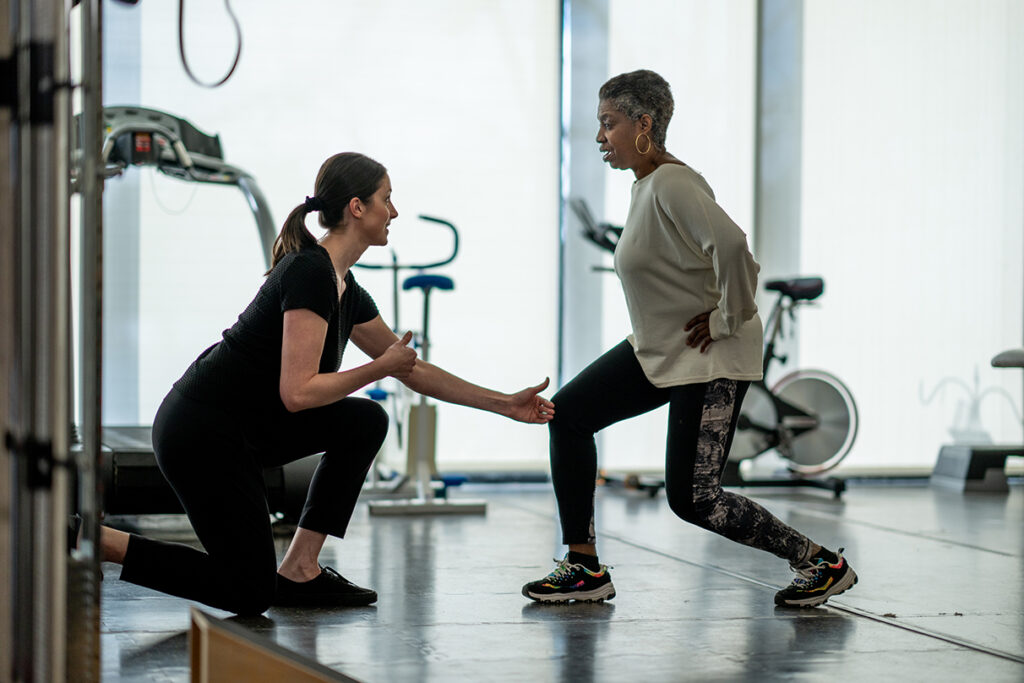
7 SEO tips for gyms
Already invested in SEO for your gym business? Or is it a new focus for you? Either way, these gym SEO tips will help you achieve success.
1. Think about how you organise your website
Website structure (also called website architecture) is how your website is organised.
A well-structured website:
- Helps Google and other search engines to find and index (store) all your website pages
- Gives search engines extra context for each page
- Spreads authority throughout your pages through internal linking
- Helps people find the content they’re looking for
Authority
DefinitionThis number is used by SEO tools to measure the relative strength of a website.
A good website structure will:
- Be flat – letting visitors reach content in as few clicks as possible. Aim for 3 or less clicks from the homepage to any other page. Some gyms choose a 1-page website. This can make it harder to rank for lots of keywords as there are fewer things you can do to optimise it
- Group relevant content together – doing this for content that’s topically related helps search engines understand how your pages are connected. It can also help you build topical authority. So, improving rankings and attracting more traffic
- Have no orphan pages – if a page is not linked to internally, it can harm SEO as visitors would need to know an exact link to get to that page
Orphan page
DefinitionThis is a webpage which has no internal links pointing to it.
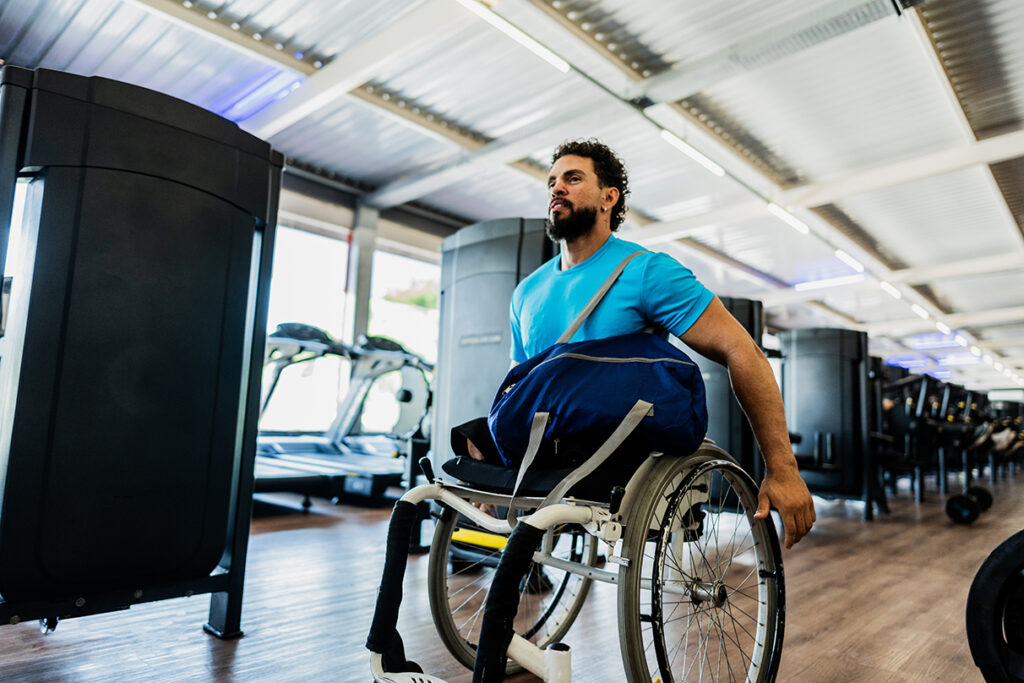
2. Focus on local gym SEO as a priority
Local gym SEO helps your business shows up for location-based searches on Google Search, Google Maps, and other search engines.
For example, it can help your Google Business Profile rank high up in the local pack:
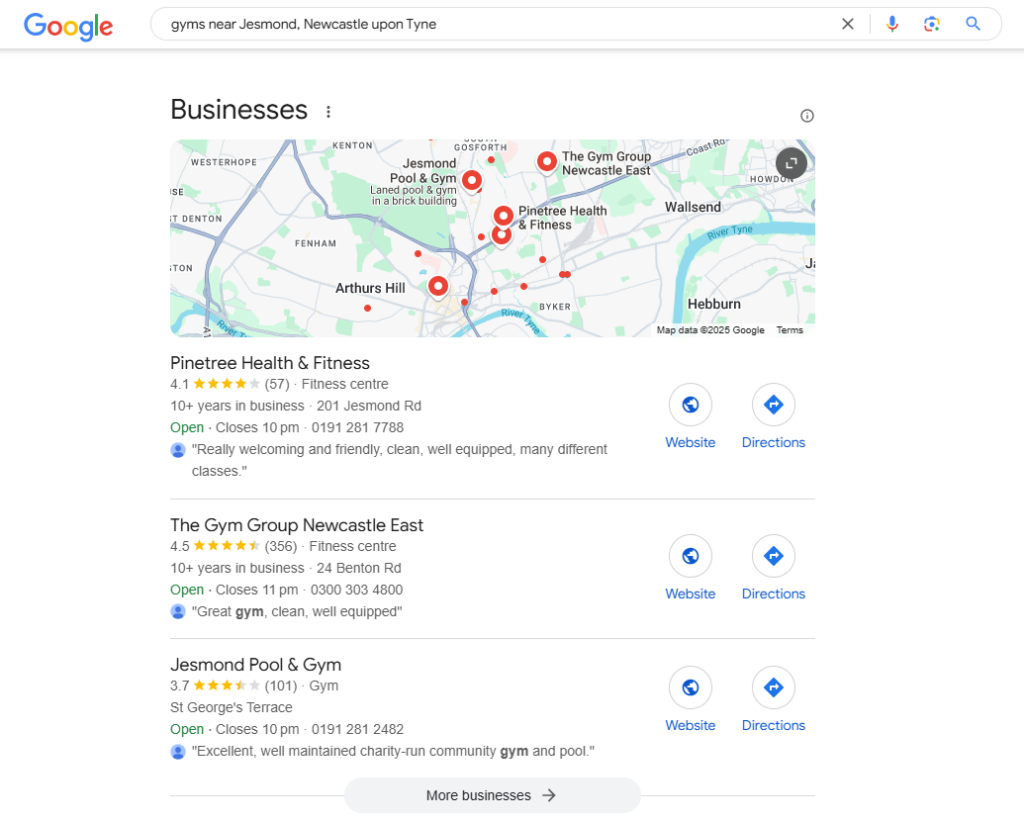
And in standard search results:
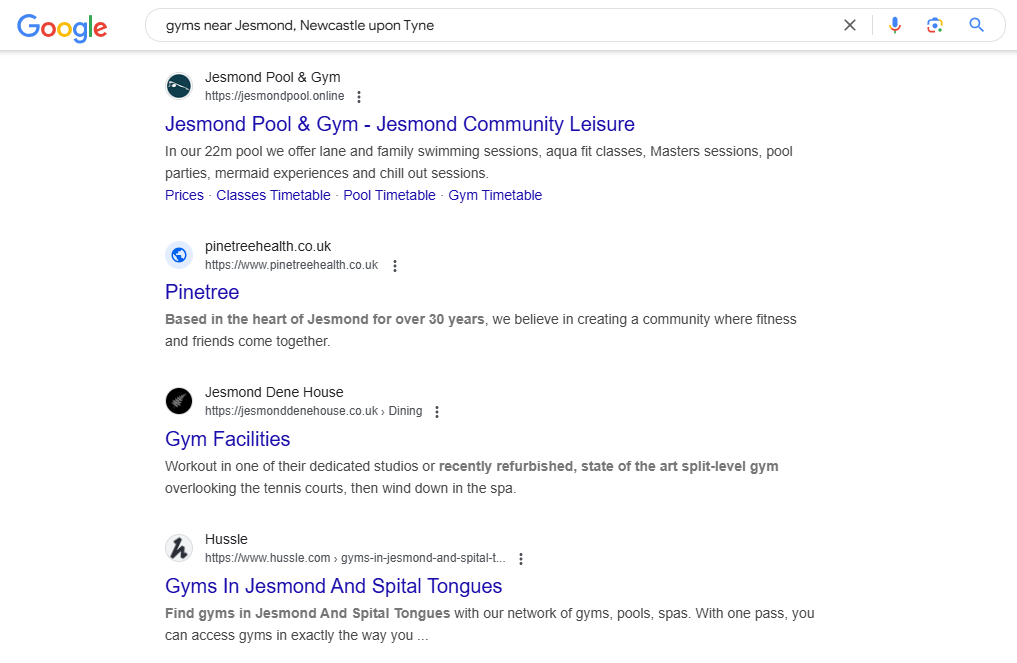
Local gym SEO makes it easier for search engines to understand your location(s), popularity, and trustworthiness. All of which can lead to higher rankings for relevant searches.
Local pack
DefinitionThis is a SERP feature that shows for local searches and displays local Google Business listings.
When ranking businesses in the local pack and Google Maps, Google considers:
- Relevance
- Distance from a searcher’s likely location
- And prominence
For webpages in standard search results, Google considers:
- Relevance
- Quality of content
- And webpage usability
How to optimise for local SEO
- Identify local keywords – for example, if you are a gym in Leeds you may look at gym near me, Leeds gym, gym in Leeds, health club Leeds, Group fitness classes Leeds, bodybuilding gym Leeds, best gym in Leeds, etc.
- Optimise your website for those keywords (see tips 3 and 4 for more on how to do that)
- Claim and optimise your Google Busineloss Profile – previously called Google My Business, this is the most important ranking factor for Google’s local pack results. It’s a free tool and takes you step-by-step on how to complete it. You’ll need different profiles for each location if you are a multi-site operator
- Get as many member reviews as possible – reviews are a major signal of how trustworthy your business and website are. Encourage members to leave positive and detailed reviews on Google – here are Googles top tips to follow
Getting listed on local directories and links on local websites can all further help you to show up in local searches for gyms.
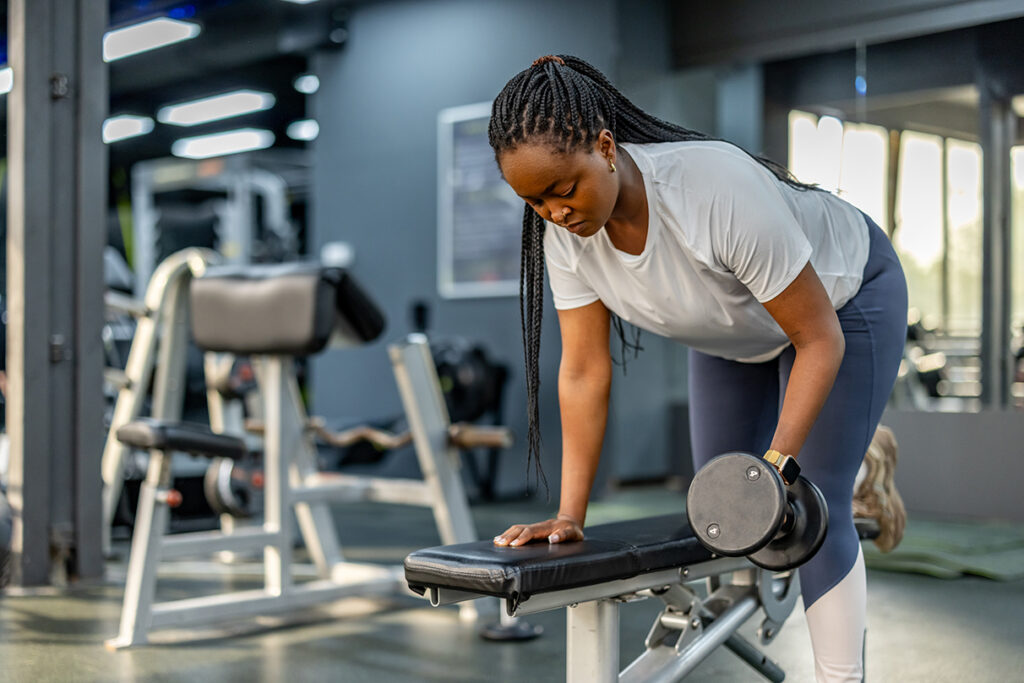
3. Build an SEO keyword strategy
Over 90% of webpages get no traffic from Google. How can you stop your webpages being part of this 90+%? It starts with keyword research.
Keywords
DefinitionThese are the words and phrases that a webpage is associated with.
Keyword research helps you find valuable search queries that your target audience is looking for using Google and other search engines.
Typical SEO keywords for gyms
Start by focusing on keywords that people who are actively considering a membership or are ready to sign up would search for.
Ideas include:
- Best gym near me
- Gym membership cost
- 24-hour gym near me
- CrossFit gym near me
- Personal trainer near me
- Strength training gym
- Group fitness classes near me
- Best gym for weight loss
- Sign up for gym membership
- Gym free trial near me
- Buy gym membership online
- Gym discounts for students
- Best deal on gym membership
- No-contract gym membership
- Gym membership for couples
You could also tailor these for a specific type of gym – for example, budget-friendly:
- Cheap gym near me
- Affordable gym membership
- Best budget gym
- Low-cost gym near me
- Gyms with no hidden fees
- 24-hour cheap gym
- Best gym for the price
- Gyms with free classes
- No-frills gym near me
- Sign up for a cheap gym
- Best gym deals near me
- Gym discounts for students/seniors/keyworkers
- Gym membership under £25
- Cancel anytime gym membership
- Gym with free trial near me
- Affordable family gym memberships
How to identify gym SEO keywords
Imagine you are a potential member – what words and phrases might you use to find solutions to your challenges?
AI tools
ChatGPT can help with this – write a prompt like ‘Suggest 10 keywords to optimise my website for as a luxury health club in Manchester’:
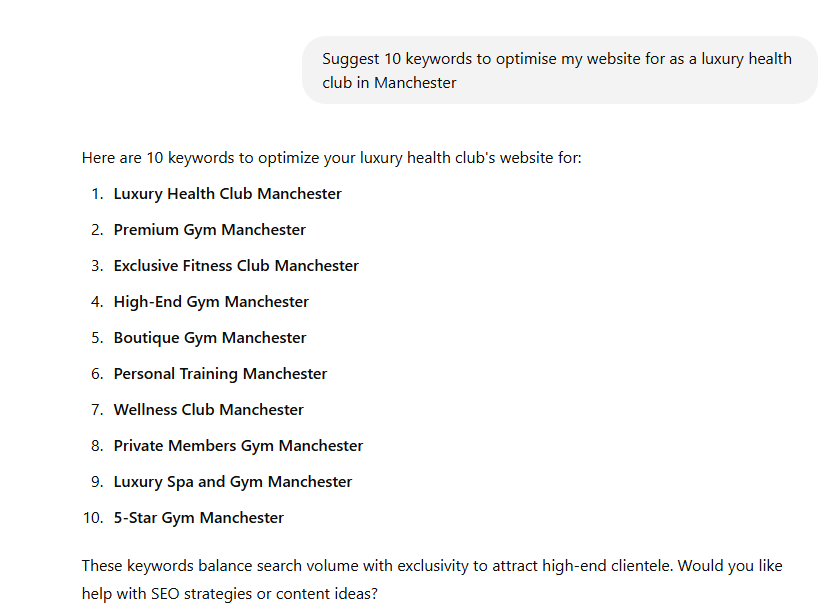
SEO tools & Google Keyword Planner
Use keyword tools to research the traffic associated with these keywords. And to get further keyword ideas. SEO tools, like Ahrefs and SEMrush, can be used for this research.
You can also use Google Keyword Planner. This free tool is accessed via a Google Ads account and is primarily used to help identify keyword ideas for ads. If you’re running paid ad campaigns, it’ll show SEO metrics like these:
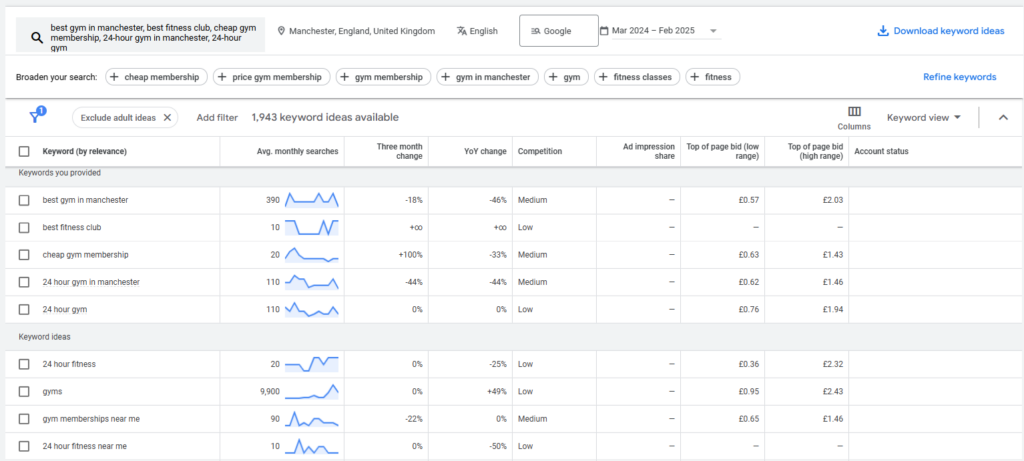
You’ll see average monthly searches for keywords you’ve entered. And get an idea of how much competition there is for each (this is paid competition but indicates likely competition for organic listing too).
Plus, you’ll see this data for a selection of other keyword ideas. So, you’ll get loads of other ideas to work with!
Competitor analysis
Another way to get SEO keyword ideas for your gym business is to look at competitor websites. SEO tools like SEMrush, Moz, and Ahrefs let you enter a competitor’s website URL and see top ranking keywords, backlinks and more.
You can also use the Google Keyword Planner tool in Google Ads to see keywords associated with a competitor’s website or a specific page. This doesn’t give you details of where pages rank like SEO tools will. It’s a good (free) starting point.
This might give you ideas for new keywords you could rank for. And it let’s you identify gaps that competitors are missing – so you can fill them and make the most of this competitive advantage.
Existing website
If you already have a website, make sure you have Google Search Console set up. This free tool will alert you to issues with your site that might impact SEO performance.
And Google Search Console will let you see some of the keywords you rank for and are getting clicks from. SEO tools can then help you work out your SERP positions for each search term.
Knowing what you rank for and where on the search engine results page you appear can help you identify areas for improvement. And along with other keyword research, you can find new opportunities to increase your reach.
Keyword clustering
Do you have a long list of keywords? No worries – you can use a process called keyword clustering to simplify this list down.
Keyword clustering
DefinitionThis is the process of combining similar keywords into groups known as clusters.
Often top-ranking pages for similar keywords are pretty much identical. Search engines will view certain search queries as subtopics of more general queries. So, you can rank for related terms using a single webpage.
Prioritising keywords
Once you have a list of keywords, you can start prioritising that list. There’s no right or wrong way to prioritise keywords for SEO (in fact, it’s a commonly debated topic in the SEO world).
Generally, it’s helpful to start by knowing more about each keyword:
Intent
Why is someone performing a certain search? Keywords can be commercial/transactional where people are ready to buy, informational, navigational, and branded/unbranded.
Knowing the search intent can help you understand the value of targeting a keyword.
Search volume
This is the average number of searches a keyword gets each month. It doesn’t mean you’d get that much traffic if you rank highly for that term.
Search volume can help you filter out very high-volume keywords that will be tough to rank for (especially if your website is newer). And it can help you look for lower-volume keywords that should be easier to rank for.
Difficulty/competition
Some SEO and keyword tools will let you see keyword difficulty or competition. This helps you understand how easy or tough it will be to rank for this term.
To rank highly for difficult keywords, you’ll usually need plenty of backlinks – create pages for these keywords as a priority. Expect to promote that page for a long time before it starts ranking.
Create something original for difficult keywords to increase the likelihood that you’ll get links.
Cost per click (CPC)
This shows the commercial opportunity of a keyword; how much advertisers would pay for clicks. It can give you an idea of the value that a keyword holds.
Growth
Many SEO tools and Google Keywords Planner will show you whether search volume has increased (or decreased) for a keyword in recent months.
This can give you an idea of what’s trending and of seasonal fluctuations. For example, we know more people join the gym in January and September, so transactional-intent searches may be higher during these months
Creating an ongoing plan
These factors will help you to prioritise keywords according to your individual business needs and your resources.
Just starting out with a new website? Or are you established and looking at SEO for the first time? Start by focusing on keywords that offer the biggest business potential – those that will help you attract decent volumes of people ready (or almost ready) to join a gym.
SEO works best as a long-term, ongoing activity. So, you could have short-, medium-, and long-term ranking goals for keywords. Spread your efforts across all three.
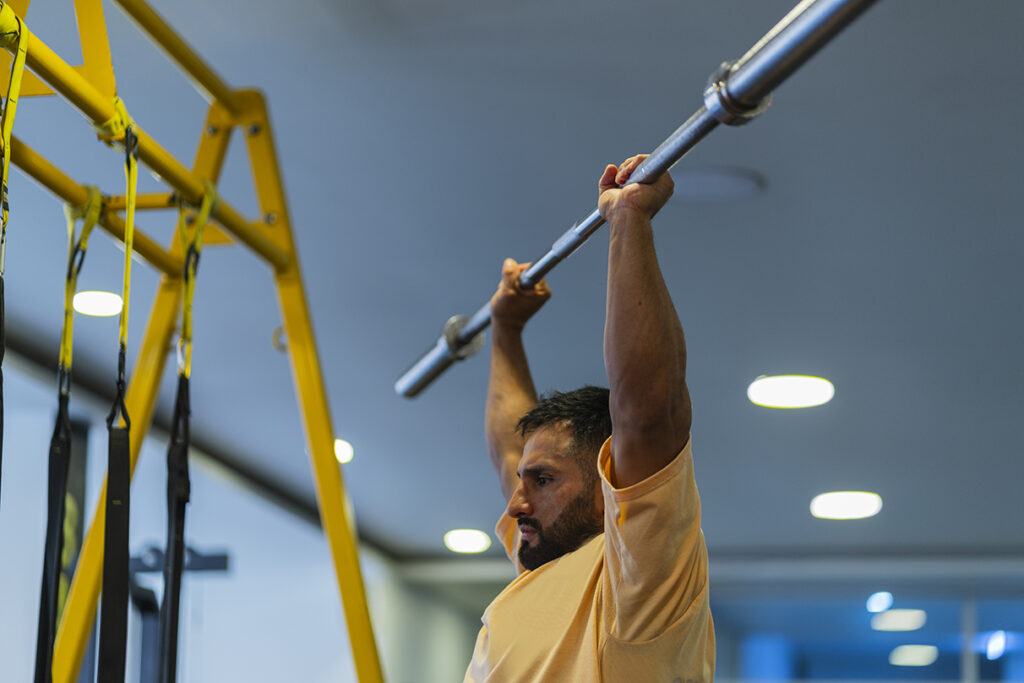
4. Create content with gym SEO in mind
Once you’ve done your keyword research and prioritised your chosen keywords, it’s time to look at content.
For most gym operators, the first focus should be keywords that offer commercial or transactional intent. So, helping you win new members.
It helps here to have keyword cluster groups. This makes it easier to work out what content you need to create. If you already have a website, you don’t always need to create new pages. Instead, you can focus on optimising the content of existing ones.
You can also look at SEO as a distribution channel for other content you are publishing on your website and platforms like YouTube.
For example, if you are a gym chain specialising in powerlifting, you may use your blog to establish yourself as a leader in the space. When planning content, research relevant keywords. And identify those that ranking highly for will help you reach a wider audience.
Target keyword
For all webpages that you’d like to rank on search engines with, you should choose a target or primary keyword. Ideally this will be the one with the biggest opportunity and greatest relevancy for your business.
This keyword will be your focus when creating and optimising your content. Related keywords you also want that page to rank for will be a secondary focus.
Content type & quality
Look at the webpages that currently rank for your target keyword. This’ll give you an idea of what Google and other search engines expect searchers will want to see.
You’ll need to start by creating the right type of content – for example, product/landing pages, blog posts, how-to guides, lists, or videos. In some cases, for commercial/transactional keywords that might be your homepage.
And you’ll need to make sure the content you’re creating is high-quality. High-quality content will:
- Be relevant, original, and compelling for your specific audience
- Avoid duplicating what’s elsewhere on your website (or the Internet in general)
- Match the search intent of your target keyword
- Answer frequently asked questions
- Be easy to read and understand – ideally set up the page so the reader can skim through. Try to choose simple words and keep sentences and paragraphs short
- Use AI with caution – over-reliance on AI can lead to a lack of originality, wrong info, and robotic writing. Always edit and fact-check outputs carefully
On-page SEO
When you create your content and set up your webpage, there are some key parts of the page that you should optimise for your target keyword (and related ones).
On-page SEO
DefinitionThis is the practice of optimising a page’s source code and visible content to rank higher.
URL structure
URLs should be kept simple – avoid publish dates, random numbers, or unnecessary text. Make sure your URL includes your target keyword to show search engines and visitors what your page is about.
For example, if you are publishing a webpage targeting ‘gym with free trial’ and have created a landing page for this your URL might be:
https://xplorgym.co.uk/offers/gym-with-free-trial
Title tag
A title tag is an HTML element that specifies a page’s title. You’ll see it in the search results, browser tab, and in social media posts. They can play a big role in whether someone clicks through to your website or not.

Your title tag should:
- Be between 50 and 60 characters (including spaces) – avoiding having some copy cut off
- Include your target keyword
- Not be the same or similar as another page on your site
Meta description
This is another HTML element. It provides a quick summary of your webpage. And is sometimes displayed in the search listings below your page’s title.
Like your title tag, your meta description plays a big role in whether someone clicks through or not. It needs to match the search intent and your page content.
Google can sometimes choose to generate its own description, follow these best practices to avoid that:
- Keep it under 120 characters (including spaces) to avoid some being cut off for mobile searches
- Include your target keyword – Google often bolds keywords that align with a particular search
- Be direct and save space by using active voice
- Add a call to action
H1 heading
A H1 title tag is an HTML heading that’s normally used to show the title of a webpage. Marking headings with different levels (H1, H2, H3, etc.) helps search engines understand the page’s hierarchy. And lets visitors skim through.
Your H1 heading or title is particularly important as it’s the main headline or title of your page. It should incorporate your target keyword to show your content is relevant.
Page content
Make sure that the content throughout your page is high-quality (see earlier in this section for guidance).
Incorporate your target keyword early on (ideally in the first sentence). And then regularly throughout your content. Also try to work in other keywords you’d like to rank for.
Do this naturally to avoid keyword stuffing – it’s better to be relevant than use every keyword!
Keyword density
DefinitionThis is the % of words on a page that match your target keywords. As a rule of thumb, aim for 2% density.
Make sure you’re using different levels of heading. You’ll need to these to be coded in the HTML, rather than adjusting font sizes. Most website content management systems make this easy.
Use H2 for subtopics. And H3 (and H4 etc.) for sections within your subtopics.
Images
Relevant images can bring life to your page – creating interest for the visitor. Google and other search engines may also rank these for image searches – driving more traffic to your website.
Alt text
DefinitionAlternative text (alt text) is a text description of an image. This is used by screen readers and search engines.
Each image should have descriptive alt text. Alt text explains your images to search engines and visitors who rely on screen readers. As with headings, alt text is added in the HTML code and most content management systems make it easy to add this.
Good alt text will:
- Be brief – under 120 characters including spaces
- Only be used for images that have a purpose
- Naturally include your target keyword
External and internal links
External links lead visitors from your website to another website. When used strategically, they can improve the user experience and build trust.
When adding external links consider:
- Is the content you’re linking to high-quality and relevant?
- How can you balance link quantity and placement to avoid looking spammy?
- Are you using descriptive, natural language in the link anchor text?
Anchor text
DefinitionThis is the visible clickable link. Anchor text is used by search engines to understand the content of a linked page.
Also add internal links using anchor text. These go to other pages on your website and help:
- Search engines get to know your site’s structure and crawl it to find new pages
- Signal that the page linked to is valuable
- Visitors move through your website and learn more about your business
Promote your content
Finally, make sure you promote your content. This will get your audience to it faster and help surface it to search engines. For example, you could promote it via social media.
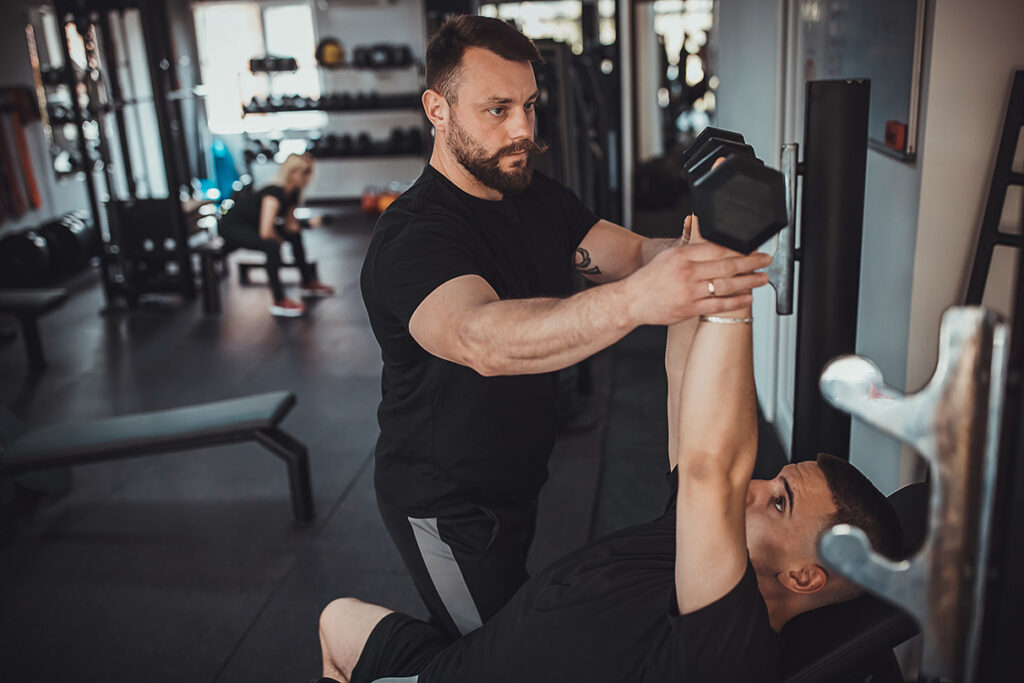
5. Look at technical SEO
Although perhaps not quite as exciting as finding keywords or creating content, technical SEO can make or break your ability to rank. So, the more you can do to get it right, the better.
Technical SEO
DefinitionThis involves making technical adjustments to your website. All to help search engines find, crawl, understand and index the pages on your site.
Why is technical SEO so important? If you get it wrong your pages may not be accessible to Google and other search engines. So, they won’t appear in search results. Meaning you could be missing out on traffic and potential revenue.
Failure to pay attention to technical aspects like your website’s speed and mobile friendliness can impact how well you’ll rank. And cause visitors to leave your site fast after a disappointing experience.
If you are not technically minded and don’t have anyone on your team who looks after your website, you may prefer to outsource technical SEO.
Crawling
Technical SEO for gyms helps search engines crawl your website. This is where search engines follow links on pages, they already know about, to find new pages they’ve not found before.
Crawling is made easier when you have an SEO-friendly website architecture that helps crawlers find your content fast. Ideally within 2-3 clicks of your homepage.
Using an XML sitemap makes it easier for Google to find your pages. This is a file that contains a list of the important pages on your site. Usually, you’ll find your XML sitemap at one of these two URLs:
- yourwebsite.com/sitemap.xml
- yourwebsite.com/sitemap_index.xml
You can submit this sitemap to Google via your Google Search Console account (head to ‘Indexing’ then ‘Sitemaps’).
Indexing
After a search engine has crawled your website, it will try to analyse and understand the content it found on each webpage. Next it will store your content in its search index.
This part is essential if you want your pages to appear in search results.
How to see if a page is indexed
TipYou can do this using the ‘site:’ operator. For example, to check the index of xplorgym.co.uk, you’ll type ‘site:xplorgym.co.uk’ into Google – you’ll see a list of (roughly) all the pages indexed. You can also do this for a specific page. For example, ‘site:xplorgym.co.uk/blog/switching-gym-management-software’.
There may be some pages that you don’t want Google to index/list. For example, thank you pages and pay-per-click landing pages. You can do this by adding the noindex tag to the <head> section of your webpage.
Lots of website content management systems have tools that let you do this without having to edit HTML.
Noindex tag
DefinitionThis is an HTML snippet that tells search engines not to index a webpage.
Other aspects of technical SEO to pay attention to
As well as making sure your website is easy to crawl and index, here are other elements of technical SEO to look at.
Use HTTPS
This helps protect sensitive visitor data like passwords and credit card details. It’s been important for ranking for more than 10 years.
HTTPS
DefinitionHTTPS stands for hypertext transfer protocol secure. It’s the secure version of HTTP.
Once you move your website to HTTPS, make sure you add redirects from HTTP to HTTPS. So, all visitors are automatically taken to the secure version.
Have 1 version of your website available
Check to see that visitors and search engines cannot access your website via two different URLs:
You’ll see here that only https://xplorgym.co.uk is accessible (anyone who goes to www. is automatically redirected).
If you keep both live, you’ll run into duplicate content issues. And you may reduce the effectiveness of backlinks you get if other sites are linking to both versions. So, you’ll find it harder to rank.
Look at page speed
How fast your website loads on both mobile and desktop is a ranking factor. Google has a PageSpeed Insights tool that you can use to check your website’s speed. You’ll be scored from 0-100. The higher your score, the better.
Have a mobile-friendly website
Google takes a mobile-first approach to indexing. It looks at mobile versions of web pages to index and rank pages. Use Google’s PageSpeed Insights tool to see if your website is compatible with mobiles.
Add structured data
Also called schema markup, structured data is code that lets search engines better understand a webpage’s content. If you can add the right structured data, you’ll be more likely to win rich snippets – these help your website stand out on the SERP.
You can find details of structured data available here. Popular options for gyms include the review snippet and local business pack.
Routinely find and fix broken pages
Ever had a 404 message when browsing a website? If you have, you’ve hit a broken page. This creates a negative visitor experience and waste any backlinks won to that page.
You can use Google Search Console to find URLs with a 404-error code (indicates a broken link). Then update them to the correct URL or remove the link if the page is not needed anymore.
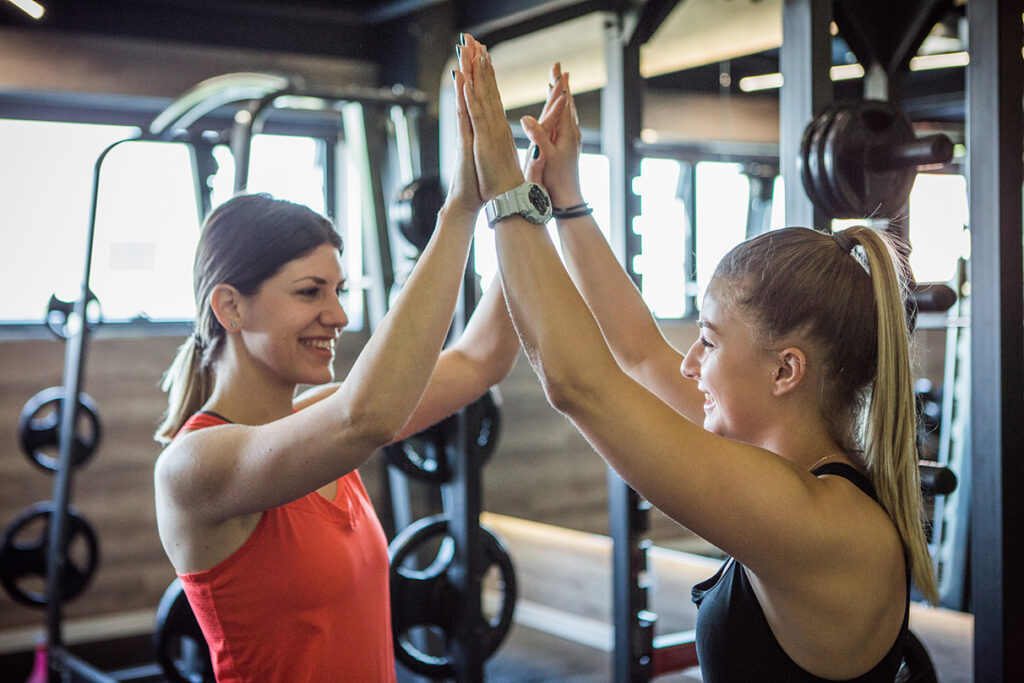
6. Identify link building opportunities
When other websites link to a page on your website, search engines are told that your content is somehow important. Pages that rank high up on SERPs tend to have more high-quality backlinks than other pages.
Backlinks
DefinitionThese are links from one page on a website to a page on another website. Search engines review the quality of each backlink to understand how important a page is.
Ways to build links
There are 4 popular ways to get backlinks:
- Asking for links – contact the owners of relevant websites to ask them to link to your webpage
- Earning links – create and promote something noteworthy so people choose to link to it
- Buying links – offering money (or something else) to owners of relevant websites in return for a link to your webpage
- Adding links – going to a website and manually adding your link. For example, social profiles, business directories, review website listings, forums
No one knows exactly what Google and other search engines determines a ‘good link’. Most agree it’s a combination of:
- Authority – a metric from SEO tools that looks at the relative strength of a website
- Relevance – how relevant content is to the needs, interests, and preferences of a visitor, a linking page should be topically relevant to the page linked to
- Anchor text – text used to link should help search engines understand what the page linked to is about
- Placement – where on the page a link is, can determine how likely it will be to get clicked. Avoid sidebars and footers. Aim for links high up on the page
- Destination – it’s often easier to get a website owner to link to an informational page rather than a transactional page. Getting lots of high-quality links to informational pages can help transactional pages rank
Where to start when creating a link building strategy
You could work with an SEO professional or link building service to get backlinks, however there’s lots you can do yourself.
Replicate competitor backlinks
Look at who links to your competitors’ homepages. If there are websites that mention your competitor, reach out to see if they’ll link to yours.
You can also use SEO tools to see which pages on a competitor’s website has the most backlinks. This’ll give you an idea of which content is attracting the most links. You can create better content on the same topics for your website.
Targeted outreach
When you’re researching keywords, you may spot top ranking pages where there’s an opportunity to ask for a link. For example, a guide to the best gyms in Portsmouth.
Create linkable assets
Sometimes, you may be able to identify relevant topics that you have expertise in which would attract links naturally. Strategically create articles, how-to-guides, and tutorials and promote these.
Guest posting
This can be a great way of building links for gym businesses like yours. Find partners and local publications who would be willing to take guest contributions.
Provide an article that shows your expertise – keep it educational – and build in one or two anchor text links to webpages on your site that are topically relevant.

7. Consider working with an SEO expert
Finally, if you’re short on time or your website isn’t ranking as well as you’d hoped, you might want to seek specialist SEO expertise. Finding the right SEO agency or consultant is vital.
Start by clearly defining your goals – what you want to achieve. That could be increasing traffic, improving specific rankings, or attracting more sales from organic search.
Identify SEO agencies/consultants who have a solid background in helping fitness businesses like yours. Make sure they’re able to show you their successes with similar clients and provide testimonials.
Make sure your chosen agency/consultant is honest about the strategies they’ll use. Avoid any practices that could result in your website being penalised. Regular communication and reporting are essential, and you should agree pricing upfront.
As much as we appreciate confidence, avoid agencies or consultants who promise you’ll rank in top positions. Achieving long-term success with SEO often means accepting fluctuations and consistently working to keep rankings high.
Closely collaborate with your chosen agency or consultant so they have all the information they need to succeed. Make sure you understand the scope of work, timelines, and who is responsible for what.

Measuring gym SEO success
When it comes to improving your rankings on Google and other search engines, it’s a marathon, not a sprint! Consistent, strategic effort over time will pay off.
Update and optimise existing content. Find new keywords and add new pages. Address technical issues and make improvements. Identify new backlink opportunities. There’s lots to keep working on!
To see long-term results from SEO make fast changes and put in a sustainable effort. And regularly measure success looking at these metrics:
Keyword ranking
Start by focusing on getting on page 1 for each term you’re targeting. Then look to secure the top spot. For competitive keywords exact positions can change regularly – try to consistently be in the top 3 to secure most clicks.
Track top keywords manually or use an SEO tool like Ahrefs or SEMrush for a more comprehensive approach.
Organic traffic
Use Google Analytics to view traffic coming from organic search. Traffic should increase overtime (you may see seasonal peaks and troughs) – look at this on a monthly basis.
Adjust your title tags and meta description to encourage more click throughs.
Time on page
You want visitors to stick around, read your content, and act. Aim to increase time spent on each page and your site as a whole. You can see time on page within Google Analytics.
Bounce rate
Ideally you want visitors to stay on your website and go on to do something else. For example, booking a tour or signing up to a membership.
So, you should aim to keep your bounce rate (the % of visitors who leave your site after that first page) as low as possible – tracking it in Google Analytics.
Domain authority
A higher domain authority means that you’re more likely to show up in searches. Use SEO tools to understand your domain authority.
Backlinks
Again, this can be tracked using SEO tools. You’ll want to pay attention to the number and quality of backlinks your website and individual pages are getting.
Power up your business & stay in the know
The wrap up…
SEO for gyms is the practice of optimising your website and its pages to appear at the top of search engine results for targeted search terms. It’s a long-term way of helping your target audience learn about your club and attracting sales.
To be successful with SEO:
- Think about how your website is structured
- Focus on local gym SEO as a key priority
- Build an SEO keyword strategy
- Create content with gym SEO in mind
- Look at technical SEO
- Identify link building opportunities
- Consider working with an SEO expert
SEO is a marathon not a sprint. You’ll need to continually work on it over time. And keep measuring key metrics to track positive improvements. Adjust your approach to address challenges.
Make it easy for new members to join your club with gym management software that includes powerful sales features.

by Joanna Ashton Content Marketing Manager, Xplor Gym
-
First published: 07 April 2025
Written by: Joanna Ashton
